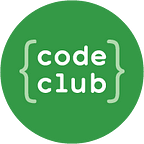Ready to start Code Club? Here are our top tips.
The start of a new year, or whenever your Code Club begins, is always full of planning, organising resources, and building enthusiasm and excitement for the possibilities ahead. We’ve talked to a number of our Code Club leaders to help you kick-start 2024. Here are their suggestions on how you can teach young people to code with Code Club — even if you’re still learning yourself.
1. Explore your Dashboard for resources
Your dashboard on the Code Club Australia website houses a wealth of resources for you to download and use. Our top picks to start the year would be:-
- Posters with terminology explained
- Certificates to present to coders
- Name badges
- Skills checklists and Learning Pathway tracking sheets
- Bingo cards for tracking student progress
- Posters to advertise when Code Club will run
- How to guides — preparing for first session, setting up technology, running a session, tracking progress, peer mentoring, and more
2. Plan some unplugged activities
Not all Code Club sessions need to be on devices. Some great unplugged activities really get kids thinking, and help to develop their computational thinking skills. In your dashboard, you can access find-a-word activities that focus on coding terminology. If you want them to be more focused on coding skills then you can try -
- instructional activities like origami and folding paper airplanes. Have students develop the instructions for others to follow and see how the end product turns out.
- paired drawing activity — have one student describe to another how to create a certain drawing. The focus is on the language to both describe the shape and also the position on the page of each part of the drawing.
3. Coding projects - Which will you choose?
If you have a new group of children it is great to start with one of the Learning Paths. These follow the 3–2–1 Make! process. Over a period of time, 6 projects are completed in order. The first 3 explore new skills. The next 2 practice the new skills. And the final project asks young people to use the new skills they’ve learned to meet a project brief. This is a great way to have kids learning, and for classrooms to help students develop their skills.
You might also opt to start with some projects that have a certain topic. Why not try -
- Code of Origin projects — each project features a state or territory of Australia and helps to teach what makes them unique
- Moonhack projects — space-themed projects designed for all ability levels
- Agriculture projects — help build some knowledge while coding
- Well-being projects — a great way for kids to learn about each other and themselves while coding
4. Be active in the Code Club Australia community
With over 2500 volunteers across Australia, there is always someone to learn from and share ideas with. Join the conversation and get great tips from the community and team of educators.
- Check out our YouTube channel with code-along videos
- Join the Code Club Australia Facebook Group — a great place to ask questions and seek advice.
- Join our online training for top tips to get started.
- Share your Code Club story with others. Complete this form and Kaye will be in contact.
- Check out past blogs for lots of ideas. Here are a few favourites
The Value of Computational Thinking
Using Scratch — tips and tricks
Machine Learning — our latest pathway of projects
Learning Pathways explained — a journey from learner to designer
Happy coding!
Kaye
Code Club Australia
